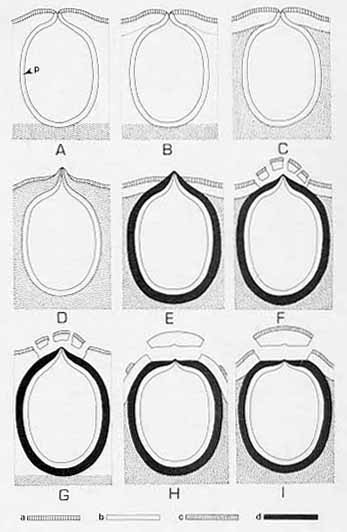









|
Shapes of stromata appear to be fairly variable.
Most taxa that produce widely effused stromata are capable of producing restricted
stromata, and the reverse is also true. These taxa tend to display tissue below the
perithecia that is thinner than the perithecial layer. In taxa such as H.
placentiforme and H.
fragiforme where the tissue below the perithecia is massive, the
stromatal shapes are quite constant and are of diagnostic value. We rely heavily on the
presence or absence of a layer of carbonaceous stromatal tissue that surrounds individual
perithecia (Fig. 1) to distinguish between the two sections of Hypoxylon
(see
SUBGENERIC TAXA OF HYPOXYLON).
This results in classifying H.
cohaerens and H.
multiforme, which do not have apparent ostiolar discs, in section Annulata
because they have a layer of carbonaceous stromatal tissue around perithecia. Surface
colors, granule colors, and stromatal pigments extracted by KOH solution are usually
stable in a taxon. However, apparent shifts of these characters from one character state
to another have been observed in a few taxa. For example, most collections of H.
fendleri have a vinaceous tone on the stromatal surface, but there are
some which have no trace of the vinaceous tone and are easily confused with H.
crocopeplum. In cases like this, cultural data are highly helpful in
making an unequivocal identification. Hypoxylon
hypomiltum has KOH-extractable stromatal pigments varying from
olivaceous, yellowish, through orangish. It is noteworthy that there are some collections
of H. crocopeplum, H. fuscum, and H.
subgilvum with whitish surfaces. They are much like their typical
counterparts, which lack whitish tones, in other features. We are not certain whether
these are simply variants or distinct taxa at this point. Distribution patterns of
different stromatal tissues (Fig. 1) are useful in identifying certain taxa. In section Hypoxylon,
the most commonly found pattern has waxy tissue occupying the space immediately beneath
the surface and between perithecia and woody tissue beneath the perithecial layer, as
exemplified by H.
rubiginosum (Fig. 1A). In H. fragiforme
(Fig. 1B) and H.
howeianum, the waxy tissue is differentiated into two colors at
different levels: the part immediately beneath the stromatal surface is red and the part
between perithecia is white. In the massive taxa such as H. placentiforme
(Fig. 1C) and H.
polyporum, the waxy tissue is largely confined to the region immediately
beneath the surface, and the space between perithecia is occupied by woody tissue which
appears to be an extension of the tissue under the perithecia. Stromata of H.
monticulosum (Fig. 1D) and its allied taxa are entirely composed of
woody tissue. In
section Annulata,
most taxa have the waxy tissue confined to the subsurface and have the woody tissue
throughout (Figs. 1 E, 1F, 1H, & 1I). Hypoxylon
stygium (Fig. 1G), H.
nothofagi, and some others have more abundant waxy tissue which extends
downwards into the space between perithecia. Fig. 1. A-I. Vertical
sections of stromata in various Hypoxylon showing the distributions of
different stromatal tissues. A. H. rubiginosum. B.
H. fragiforme. C. H. placentiforme.
D. H. monticulosum. E. H. multiforme.
F. H. annulatum. G. H. stygium.
H. H. nitens. I. H. bovei.
a: outermost stromatal layer; b: waxy stromatal tissue; c: woody
stromatal tissue; d: carbonaceous stromatal tissue; p: perithecial wall.

|



